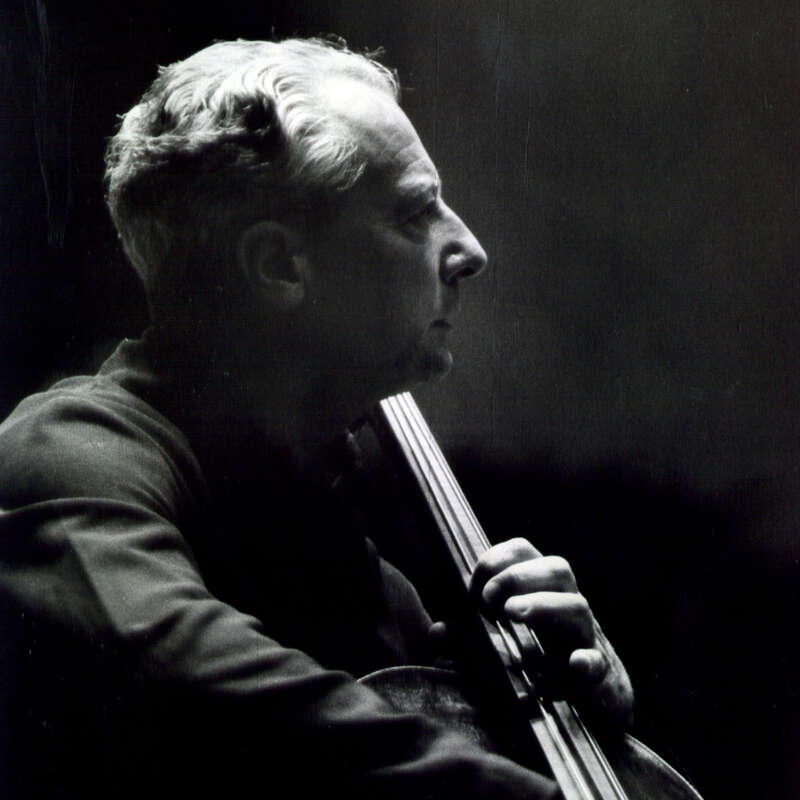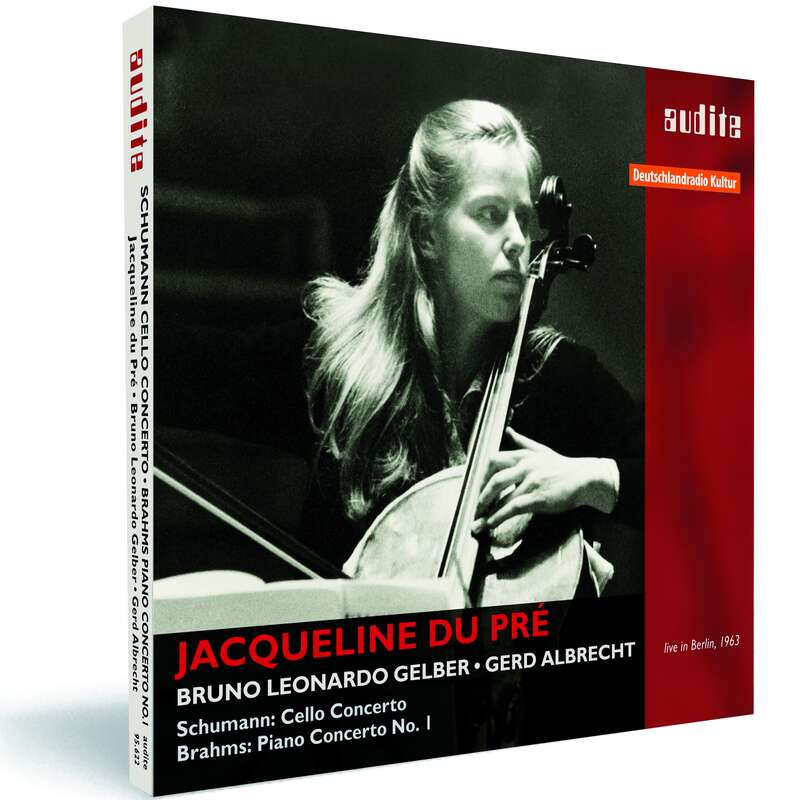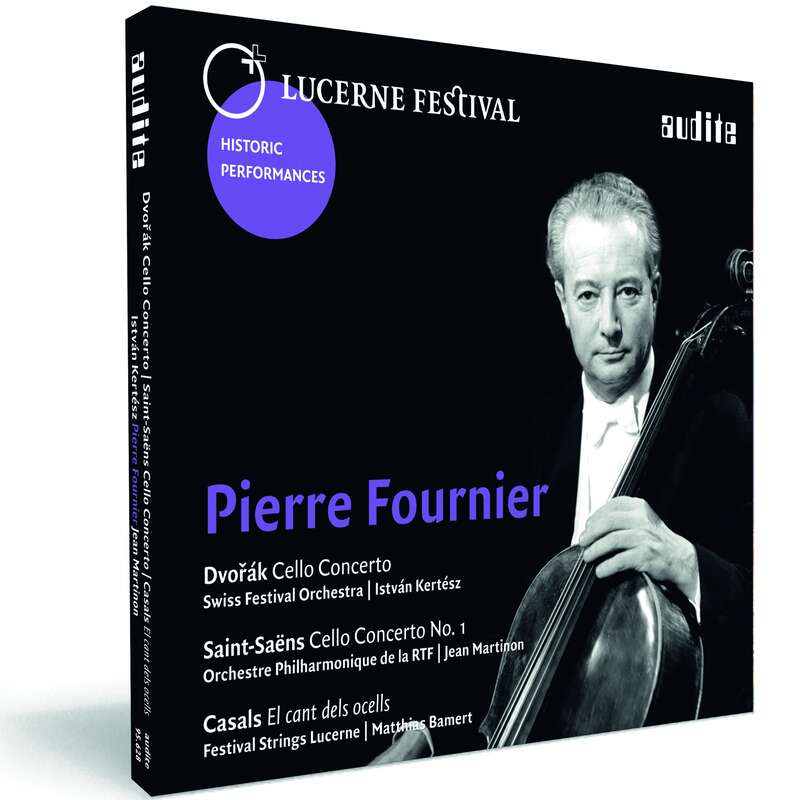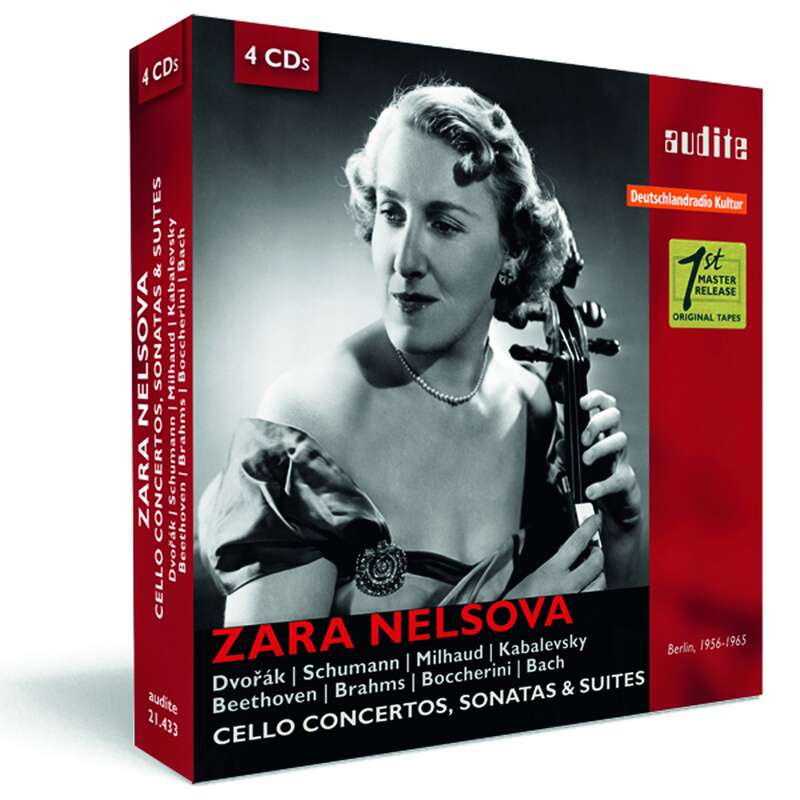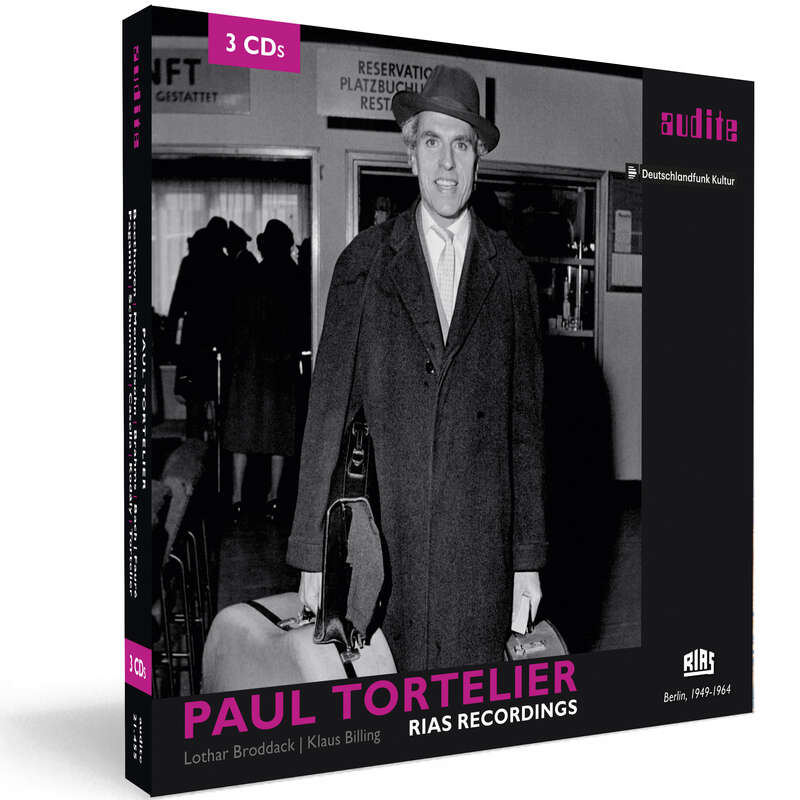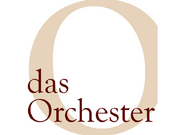This audite series with studio productions and live recordings from the years 1949 to 1976 from the archive of Swiss Radio and Television (SRF) and the German Radio Archive (DRA) provides an overview of the legendary cellists of this period, including Pierre Fournier and Paul Tortelier as well asmore
Gerd Albrecht | Georg Ludwig Jochum | Matthias Bamert | Jean Martinon | István Kertész
"As always, the sound quality on this Audite disc is world class, as are the performers." (Strings Magazine)
Track List
Multimedia
-
Producer's Comment
First-hand impressions of producer Ludger Böckenhoff [German]
-
press kit
press kit_du Pré_Gelber_Albrecht
- press kit
-
- Producer's Comment
- DigiBooklet
- digibooklet
- Historical reviews
- BR-Klassik_CD-Tipp_20151012
- Digibooklet Paul Tortelier
-
Producer's comment
First-hand impressions of producer Ludger Böckenhoff [German]
- Longlist 2/2020 of German Record Critics' Award (PdSK)
Informationen
This audite series with studio productions and live recordings from the years 1949 to 1976 from the archive of Swiss Radio and Television (SRF) and the German Radio Archive (DRA) provides an overview of the legendary cellists of this period, including Pierre Fournier and Paul Tortelier as well as the both pivotal figures for the establishment of female cellists Zara Nelsova and Jacqueline du Pré. Pierre Fournier (1906-1986) was one of the most eminent cellists of the generation after Pablo Casals. Praised as an "aristocrat of cello playing", he was admired for his soulful, singing tone, his uncomplicated elegance and his refined sound. This disc presents three live recordings from this legacy, recorded at LUCERNE FESTIVAL and all of them released for the first time, including Saint-Saëns' First Cello Concert in A minor, Op. 33 as well as Casals Cant dels ocells. Beside this Fournier performed together with István Kertész a piece of his core repertoire in the summer of 1967: Antonín Dvořák's Cello Concerto in B minor, Op. 104 – a particularly noteworthy archive discovery since the conductor's tragically early death had prevented him from making a studio recording of the concerto. The recordings of Zara Nelsova from the sound archives of RIAS Berlin, made between 1956 and 1965, complement her discography substantially, giving a more rounded impression of her artistic profile. They include works which Nelsova never recorded commercially and which are available on disc for the first time, such as the Cello Concertos by Darius Milhaud (No 1) and Dmitri Kabalewski (No 1). A great moment in Berlin’s post-war musical life: on 5 March 1963 the 18-year-old cellist Jacqueline du Pré and the 22-year-old pianist Bruno Leonardo Gelber made their solo concerto débuts. The poetry, energy and musical coherence of du Pré’s interpretation of the Schumann Cello Concerto rank alongside her later recording of the piece. The latest production in this series is dedicated to the exceptional French cellist Paul Tortelier, whose studio recordings from 1949-1964 for the Berlin RIAS are published here for the very first time and impressively reflect the enormous range of his repertoire.
Reviews
Rondo | 2/2024 (April/Mai 2024) | Kai Luehrs-Kaiser | March 22, 2024 Blind gehört – Jan Vogler: „Rostropowitsch greift rein!“
"Das Stück spiele ich nicht. [...] Es ist aber berühmt. Und wird hier von einem sehr guten Cellisten gespielt. [...] 1949, sagen Sie? Dafür klingt die Aufnahme sehr gut. [...] Der stählerne Ton immerhin, den wir hier hören, könnte auf Paul Tortelier hindeuten. [...] Eine ganz tolle Persönlichkeit, muss ich sagen."Mehr lesen
Classica – le meilleur de la musique classique & de la hi-fi | N° 259 - Février 2024 | Michel Le Naour | February 1, 2024
L’œuvre en bref
Sonate pour violoncelle seul de Zoltán Kodály
Paul Tortelier, Don Quichotte du violoncelle, brave avec panache les écueils de l’œuvre et soulève des montagnes (EMI, 1979). Auparavant, à la radio de Berlin (RIAS) en 1949, il se montre encore plus ardent (Audite, 2020). Mehr lesen
Classica – le meilleur de la musique classique & de la hi-fi | Numéro 229 - Février 2021 | Thomas Deschamps | February 1, 2021
Tortelier ne sonnait jamais de manière lisse au concert; il se montrait impétueux, contradictoire, bouillonnant, à l'image de l'homme engagé qu'il fut. Rien que pour témoigner de cela, ces trois CD doivent être thésaurisés.Mehr lesen
American Record Guide | August 2020 | David W. Moore | August 1, 2020
Paul Tortelier (1914-90) was one of the greatest cellists of his time. This program consists of first releases of recordings he made in 1949, 1962,Mehr lesen
Magcentre | samedi, 6 juin 2020 | June 6, 2020 | source: https://www.magc... Le violoncelliste Paul Tortelier chez EMI et AUDITE
Le coup d’archet de l’homme à la pique oblique est magnifique.Mehr lesen
Lion Magazine | Juin 2020 | Claude Lamarque | June 1, 2020 | source: https://mydigima...
Ces trois CD représentent des moments extraordinairesMehr lesen
BBC Music Magazine | June 2020 | Michael Church | June 1, 2020
Historical
Michael Church listens to live recordings by legendary stars of the last century
Paul Tortelier as a musician and teacher believed that music's vertical and linear dimensions – harmony and counterpoint – should be kept inMehr lesen
Diapason | N° 690 - Mai 2020 | Jean-Michel Molkhou | May 1, 2020
Tout feu tout flamme
Puisé dans les archives de la Radio (américaine) de Berlin, un portrait vibrant et fantasque de Paul Tortelier, où Casella, Kodaly et Fauré croisent Brahms, Mendelssohn, Bach, Fauré…
Audite poursuit son exploration des archives de la RIAS – la Radio créée à Berlin Ouest par les troupes américaines d'occupation dès la fin deMehr lesen
Régulièrement invité à Berlin, depuis le triomphe de sa première apparition en 1947 sous la baguette de Sergiu Celibidache, le grand violoncelliste français prit connaissance des studios de la toute récente station berlinoise les 12 et 13 février 1949, lorsqu'il y grava son unique témoignage dans les Fantasiestücke op. 73 de Schumann en compagnie du pianiste Klaus Billing. Une vision intensément lyrique et rythmiquement très libre, qui atteste déjà sa personnalité romanesque, à laquelle la prise de son confère une spectaculaire présence.
Feu d'artifice
Il enregistre, lors de la même session, la prodigieuse sonate de Kodaly (son unique version officielle, pour Emi, ne sera réalisée que trente ans plus tard), sans aucun montage et dans les conditions du concert. Si quelques petits écarts d'intonation sont perceptibles, jamais Tortelier ne perd le fil d'un discours intensément narratif et souvent fantasque, parcourant un paysage harmo-nique complexe. L'évocation des instruments du folklore populaire hongrois, donnant l'illusion d'une polyphonie, produit le feu d'artifice voulu et confirme la prodigieuse maîtrise de l'interprète.
Tortelier glisse également dans le programme une de ses propres compositions. publiée la même année (1949), Trois p‘tits tours, dont c'est ici le seul enregistrement intégral. Et le complète par une vision dense de la Sonate en mi mineur de Brahms, grave el profonde, notamment dans un Allegretto au tempo très retenu. La rare Sonate op. 45 d'Alfredo Casella (1927), captée le 30 janvier 1962 et dont la vive et inventive Bourrée comme l'impulsive Gigue finale méritent la découverte, constitue un autre apport à la discographie de Tortelier.
Les autres documents permettent de retrouver cet artiste attachant dans quelques pages fondamentales du répertoire, accompagné des pianistes « maison » de la Radio berlinoise. Il y démontre tour à tour autorité et pureté de style (Bach, Beethoven), lyrisme exubérant et goût du risque (Mendelssohn), grâce et touchante poésie (Fauré).
Deux pièces de virtuosité, Papillon et la Fantaisie Moἵse, complètent ce formidable ensemble, en mettant en valeur l'éblouissante technique de l'un des plus grands maîtres français du xxe siècle.
Gramophone | May 2020 | Rob Cowan | May 1, 2020
What we have here, to quote Rüdiger Albrecht’s comprehensive Prior to the Casella Tortelier gives us an often contemplative, broadly paced accountMehr lesen
The second disc opens with an emphatic account of Bach’s Sixth Solo Suite, set at a lower pitch than Tortelier’s generally more colourful 1982 London recording (Warner), whereas Fauré’s G minor Sonata (always a work that Tortelier excelled in), although memorable, traces a less subtle line than the version he made with Jean Hubeau for Erato, especially in the Andante second movement. The first disc opens with an account of Beethoven’s last cello sonata that’s reflective and assertive by turns, Broddack here on very good form, before Tortelier treats us to a warmly communicative reading of Mendelssohn’s Second Sonata, again with Broddack (Feuermann most readily comes to mind here), before Klaus Billing takes over for an unhurried and well-argued account of Brahms’s First Sonata. The virtuoso aspect of Tortelier’s personality is represented by the Paganini/Silva ‘MosesFantasia’, which is brilliantly played. And the emergent personality throughout this set? A great cellist and a deeply human personality whose performances, comparing one with another, are deeply satisfying and in general very consistent. The transfers, taken from clean original mono tapes, fall pleasingly on the ear.
Audio | 5/2020 | Andreas Fritz | May 1, 2020
Er war einer der besten Cellisten des 20. Jahrhunderts: Paul Torteller (1914-1990), der unter anderem auch als Lehrer, Komponist und Dirigent wirkte.Mehr lesen
Gramofon | 2020. 04. 16. | Ildikó Lehotka | April 16, 2020 | source: http://www.gramo... Tortelier és Berlin
A francia csellista játéka élvezetes, rendkívül szenvedélyes, olyan hőfokkal tolmácsolja a műveket, hogy az energia a hallgatót is odaszögezi a lejátszóhoz. Mehr lesen
Audiophile Audition | Apr 13, 2020 | Gary Lemco | April 13, 2020 | source: https://www.auda...
"[...] this RIAS collection will retain an essential place in this artist’s legacy." (Audiophile Audition)Mehr lesen
Der neue Merker
| 09.04.2020 | Alexander Walther | April 9, 2020 | source: https://onlineme...
3-CD-Kollektion mit dem Cellisten Paul Tortelier bei audite erschienen
Meister der Phrasierungskunst
Torteliers Abschied von Berlin fiel in eine Zeit des Mauerfalls. Bei seinemMehr lesen
Stretto – Magazine voor kunst, geschiedenis en muziek | april 3, 2020 | Michel Dutrieue | April 3, 2020 | source: https://www.stre... 3 bijzondere cd’s op het label Audite. Uniek!
Paul Tortelier (1914-1990) was, naast Pierre Fournier, de grootste Franse cellist van zijn tijd en een van de meest gevraagde, internationaleMehr lesen
Paul Tortelier, geboren in Parijs, werd op twaalfjarige leeftijd student aan het Conservatorium van Parijs, waar hij vier jaar later afstudeerde als beste cellostudent. Zijn leraren waren Louis Feuillard, (1872-1941), de auteur van de belangrijke “Exercices journaliers” voor cello en Gérard Hekking, en zijn docent harmonieleer was Jean Gallon (1878-1959). De Nederlands-Franse cellist, (1879-1942) Gérard Hekking was ook de leraar van Pierre Fournier en Maurice Gendron. en Gallon was ook de leraar van o.a. Maurice Duruflé, en Olivier Messiaen. Van 1935 tot 1937 was Tortelier solocellist van het Orchestre Philharmonique de Monte Carlo. Hier speelde hij onder andere de solopartij in Richard Strauss’ Don Quichote. Dit stuk werd later veelal geassocieerd met Tortelier. Hij voerde het vaak uit en maakte er ook opnamen van. In 1939 trad hij toe tot het Boston Symphony Orchestra. In 1947 maakte hij zijn debuut in het Verenigd Koninkrijk, waar hij opnieuw Don Quichote van Richard Strauss speelde. In 1950 werd Tortelier door Pablo Casals geselecteerd om te spelen als eerste cellist in het Prades Festival Orchestra.
Paul Tortelier werd in 1956 professor aan het Conservatorium van Parijs. In 1969 verliet hij als gerenommeerd pedagoog, het Conservatorium voor de Folkwanghochschule in Essen, waar hij bleef tot 1975, en daarna gaf hij nog van 1978 tot 1980, les aan het Conservatorium van Nice. Tortelier gaf les aan o.a. Jacqueline du Pré. In 1955 maakte hij met de toen wereldberoemde, Engelse pianist/begeleider (senior staff accompanist van de BBC), Ernest Lush (1908-1988) zijn televisiedebuut op de BBC. Daarna gaf hij voor de Britse televisie nog een reeks masterclasses die een groot succes waren. Tortelier schreef ook het boek, “How I Play, How I Teach” (“Comment je joue, comment j’enseigne”), uitgegeven door Chester in Londen in 1973.
Tortelier is tweemaal getrouwd. Zijn eerste huwelijk, met Madeleine Gaston, eindigde in 1944 in een scheiding. Daarna huwde hij met de celliste, Maud Monique Martin . (°1951) (foto). Uitzonderlijk is het feit dat hij zijn kinderen terugtrok uit het formele onderwijs om zich enkel aan de muziek te kunnen wijden. Tijdens een interview op de Britse tv werd hem gevraagd of er geen autoriteiten in Frankrijk waren waardoor je kinderen naar school moest sturen. Hij antwoordde: “Ik ben een solist en zij zullen solist zijn.” Zijn zoon, de als violist opgeleide, Yan Pascal Tortelier (°1947), die les kreeg van o.a. Nadia Boulanger, is een internationaal bekend dirigent geworden, zijn dochters, Maria de la Pau (foto’s) is pianiste, en zijn andere dochter, Pomone, is celliste,fluitiste en zangers…
Maria de la Pau (foto’s) werd geboren in 1950 tijdens het eerste festival Pablo Casals in Prado. Casals (foto) werd haar peetvader (foto) en gaf haar de naam Pau (vrede), die zij naast haar familienaam gebruikt. Op vijfjarige leeftijd kreeg zij haar eerste piano- en vioollessen waarna zij definitief voor de piano koos. Zij voltooide haar opleiding aan het conservatorium van Parijs bij Jeanne-Marie Darré en lelia Gousseau, en na haar studie in Parijs volgde ze les bij de pianist en Brahms specialist, Detlef Kraus in Essen.
Lothar Broddack (1930-2019) was als pianist vooral actief in de jaren vijftig. Hij maakte een aantal opnames met celliste Zara Nelsova voor Decca en begeleidde ook de violist, Michael Rabin. Hij was een ervaren pianist die piano doceerde aan de Universität der Künste in Berlijn. De Duitse pianist Klaus Billing werd geboren in Düsseldorf in1910 en overleed in Berlijn in 1991. Hij maakte in de late jaren ’40 en de jaren ’50, naast Hertha klust, naam als begeleider van de jonge Dietrich Fischer-Dieskau.
Rondo | 2/2020 | Guido Fischer | April 1, 2020
Das ist Musik mit ganz großem Herzen gespielt, ohne nur einmal den pathetischen Bogen zu überspannen.Mehr lesen
www.ResMusica.com | 25 mars 2020 | Frédéric Muñoz | March 25, 2020 | source: https://www.resm... Les archives du violoncelliste Paul Tortelier à la radio de Berlin
Plus anciennes que ses enregistrements plus officiels des années 70 pour EMI, ces gravures primitives sont le reflet de l’art d’un jeune et pétulant virtuose. Elles enrichissent le patrimoine discographique lié à cet artiste, dont le jeu évolua beaucoup tout au long de sa carrière.Mehr lesen
www.artalinna.com
| 22 MARCH 2020 | Jean-Charles Hoffelé | March 22, 2020 | source: http://www.artal...
LE DISQUE DU JOUR
Voix Humaine
La discographie de Paul Tortelier aura conservé son art tel quel, rugueux,Mehr lesen
http://operalounge.de
| 11.03.2020 | Dr. Geerd Heinsen | March 11, 2020 | source: http://operaloun...
Ein Großer
Paul Tortelier: Seltene RIAS Recordings bei audite
Bei audite sind selten gehörte Radioaufnahmen aus den Tiefen des Rias-Archives mit dem französischen Cellisten Paul Tortellier erschienen. PaulMehr lesen
Der Kollege Kai Luehrs-Kaiser sagte dazu im rbb kultur radio: Auf drei CDs sind die gesammelten „RIAS Recordings“ des französischen Cellisten Paul Tortelier erschienen – Aufnahmen aus den späten 40er bis mittleren 60er Jahren. Wer ist Paul Tortelier? Paul Tortelier (1914 – 1990) war der wichtigste Cellist der französischen Schule der Nachkriegszeit – neben (dem noch etwas bedeutenderen) Pierre Fournier. Schon 1947 machte Tortelier sich ins noch reichlich kaputte Berlin auf; gewiss auch in Anlehnung an die Bedeutung der Musikstadt in der Vorkriegszeit; wo sowohl Arthur Rubinstein (mit dem er jahrelang ein wichtiges Trio bildete) wie die meisten anderen Musiker seiner Zeit debütiert hatten.
Immer wenn Tortelier in den Folgejahren kam, wurde er sofort vom RIAS für Aufnahmen abgezweigt – meist mit dem erst im letzten Dezember verstorbenen Pianisten (und späteren Berliner Hochschullehrer) Lothar Broddack als Begleiter. Es waren ersichtlich Auftragsarbeiten (von 1949 bis 1964). Mit Bach etwa (kurz bevor er sich mit Pablo Casals anfreundete) fremdelt Tortelier 1949 noch hörbar. Superb dagegen seine ausgewählten Beethoven-, Brahms-, Mendelssohn-, Fauré-, Kodaly- und Casella-Sonaten. (…)
Einige Aufnahmen entstanden sogar noch im alten (Berliner) Kleistsaal. Nicht nur hinsichtlich der französischen Cellistenschule, sondern auch als Berliner Dokument ein höchst schätzenswertes, gewohnt topsolide aufgemachtes audite-Set. Übrigens war Tortelier – als Lehrer von Jacqueline du Pré – 1967 Trauzeuge bei der Hochzeit du Prés mit Daniel Barenboim. Noch ein halbberliner Aspekt also … Noch bis 1989 war er in Berlin zu Gast – teilweise gemeinsam mit seinem in Berlin als Dirigent wirkenden Sohn Yan-Pascal Tortelier (beim damaligen SOB etc.).
www.musicweb-international.com | Monday March 2nd | Jonathan Woolf | March 2, 2020 | source: http://www.music...
Paul Tortelier’s international career began in 1947 in which year he first visited Berlin to perform; the first of two concerts had to be cancelledMehr lesen
The most exciting thing about this tranche of previously unreleased broadcast performances is that Tortelier left no studio inscriptions of three of the works performed – the Casella sonata and, rather surprisingly, the Schumann Fantasiestücke, and his own Trois p'tits tours. Of this last he frequently performed as an encore, and recorded, the brilliant third piece, Le Pitre but he never recorded the remaining two.
That should be inducement enough at least to consider this splendidly realised release but then there are the more-or-less staples of his repertoire to consider as well. The sequence begins in 1949 with Brahms’ Sonata No. 1, the Schumann, the Kodály and his Trois p'tits tours, all in typically fine sound and accompanied by Klaus Billing. The Brahms is eloquently refined though he tightened up the finale in his 1977 EMI recording with his daughter, Maria de la Pau. The Schumann is valuable not merely because of its absence in his commercial discography but also because it’s a lyrical and persuasively sung reading. Tortelier fanciers will know that Le Pitre is a fizzy piece of Gallic wit but the companion pieces are almost as characterful in their different ways, not least the charming Ballerine, a winsome waltz. Whilst he may not have the public profile in the Kodály that János Starker did, Tortelier left behind a particularly memorable recording of it nearly thirty years after this Berlin reading. Superbly coordinated and expressively powerful, it and this Berlin performance offer a less explicitly tensile reading than Starker’s but one that is similarly lucid. Later that same year RIAS recorded him in Bach’s Sixth Cello Suite. Similar in conception to the much later 1982 London cycle, his voicings in the Courante are especially compelling and the close-up recording catches a few fingerboard details and shifts.
The Fauré and Casella sonatas come from January 1962, now with Lothar Broddack. Tortelier taped both Fauré sonatas with Jean Hubeau for Erato in the ‘60s – more recently reissued on Warner Classics CD – though the later Eric Heidsieck recordings for EMI in the very early 1970s will be better known. Both are beautiful but the Hubeau catches a real pair of near equals at work and was taped commercially at around the same time as this Berlin performance. Broddack was a fine artist but hasn’t quite the idiomatic flexibility of Hubeau. I wonder why the cellist never recorded the Casella as he plays it with real flair, extracting its Mediterranean rhythms and colour, its amiable crispness and moving tolling quotient, with great subtlety – his control of dynamics and bowing subtleties just as impressive as his left-hand mobility.
The final broadcast comes from 25 February 1964. Beethoven’s Sonata No. 5 in D Major, Op. 102 No. 2 features a much more funereal slow movement than in his later LP with Heidieck whilst in Mendelssohn’s Sonata No. 2, where the Berlin tempo is mostly faster than his 1978 LP with de la Pau, neither performance sounds unduly rushed nor dawdling in comparison with the other. Tortelier recorded his own orchestrated arrangement of Paganini’s Introduction and Variations on 'Dal tuo stellato soglio' with his wife Maud and the ECO in 1973. The piano-accompanied version in Berlin is the work of cellist Luigi Silva (1903-1961), who had in fact recorded the work for Electrola back in 1938 (it would be good to have Silva’s small corpus of 78s restored; these days he’s far better known as an arranger and teacher than performer and recording artist). Tortelier’s wonderful insouciance never slides into complacency; this is refined but truly communicative virtuosity in action. Fauré’s Papillion is the encore.
The pieces are not grouped by recording date but are scattered throughout as seems appropriate. The sound quality is not so radically different that this presents any concern but maybe some listeners would have preferred a chronological sequencing though I can’t say it worried me at all. The three additions to Tortelier’s discography, on the other hand – especially the Casella – are splendid to have and offer richly rewarding listening, as do all the recitals.
RBB Kulturradio | 26.02.2020 | Kai Luehrs-Kaiser | February 26, 2020 | source: https://www.rbb-... BROADCAST
Das ist lange her. Auf drei CDs sind die gesammelten "RIAS Recordings" des französischen Cellisten Paul Tortelier erschienen – Aufnahmen aus denMehr lesen
Paul Tortelier (1914 – 1990) war der wichtigste Cellist der französischen Schule der Nachkriegszeit – neben (dem noch etwas bedeutenderen) Pierre Fournier. Schon 1947 machte Tortelier sich ins noch reichlich kaputte Berlin auf; gewiss auch in Anlehnung an die Bedeutung der Musikstadt in der Vorkriegszeit; wo sowohl Arthur Rubinstein (mit dem er jahrelang ein wichtiges Trio bildete) wie die meisten anderen Musiker seiner Zeit debütiert hatten.
Bereitschaft zur Unverwechselbarkeit
Immer wenn Tortelier in den Folgejahren kam, wurde er sofort vom RIAS für Aufnahmen abgezweigt – meist mit dem erst im letzten Dezember verstorbenen Pianisten (und späteren Berliner Hochschullehrer) Lothar Broddack als Begleiter. Es waren ersichtlich Auftragsarbeiten (von 1949 bis 1964). Mit Bach etwa (kurz bevor er sich mit Pablo Casals anfreundete) fremdelt Tortelier 1949 noch hörbar. Superb dagegen seine ausgewählten Beethoven-, Brahms-, Mendelssohn-, Fauré-, Kodaly- und Casella-Sonaten.
Tortelier selbst erklärte den französischen Stil seines Spiels mit einer "subtilen, nervösen" Bogenhand. Der fragile, elegante und sehr freie Ton wurde also von der Rechten generiert. Die heute vielfach anzutreffende Bewunderung für Tortelier (und für Fournier) rührt wohl daher, dass der auf großen Ton und stilistische Universalität geeichten Gegenwart nichts so fern steht wie Torteliers Spezifik und Bereitschaft zur Unverwechselbarkeit.
Topsolide
Einige Aufnahmen entstanden sogar noch im alten Kleistsaal. Nicht nur hinsichtlich der französischen Cellistenschule, sondern auch als Berliner Dokument ein höchst schätzenswertes, gewohnt topsolide aufgemachtes Audite-Set. Übrigens war Tortelier – als Lehrer von Jacqueline du Pré – 1967 Trauzeuge bei der Hochzeit du Prés mit Daniel Barenboim. Noch ein halbberliner Aspekt also ... Noch bis 1989 war er in Berlin zu Gast – teilweise gemeinsam mit seinem in Berlin als Dirigent wirkenden Sohn Yan-Pascal Tortelier (beim damaligen SOB etc.).
Süddeutsche Zeitung | 17. Februar 2020 | Harald Eggebrecht | February 17, 2020 | source: https://www.sued...
Ein Star, zwei Talente
Neue CDs: Beim Cellisten Paul Tortelier weiß man, was man hat - virtuosen Glanz. Von Raphaela Gromes wird man noch viel hören.
Drei hörenswerte CDs mit Aufnahmen aus den Jahren 1949, 1962 und 1964, die er [Tortelier] mit den Pianisten Klaus Billing und Lothar Broddack in Berlin für den Rias machte, künden vom "sprechenden", bei aller Brillanz nie glatten, sehr persönlichen Spiel aus solistischem wie kammermusikalischen Geist dieses einzigartigen Cellisten.Mehr lesen
www.pizzicato.lu | 11/02/2020 | Remy Franck | February 11, 2020 | source: https://www.pizz... Eigenwilliger, unnachahmlicher Paul Tortelier
Ein französischer Kritiker schrieb: « Falls Casals Jupiter ist, dann ist Tortelier Apollo ». Paul Tortelier (1914-1990), ein wichtiger Exponent derMehr lesen
Die erste CD beginnt mit Beethovens 5. Cellosonate, die zwischen vitalen Ecksätzen ein über neun Minuten langes, mit viel Affetto gespieltes Adagio enthält. So verspielt Tortelier dann in Mendelssohn Zweiter Sonate sein kann, so rhetorisch-bedeutsam und leidenschaftlich-lyrisch spielt er die Erste Sonate von Brahms.
Bach zählte zu den Komponisten, mit denen sich Tortelier zeitlebens beschäftigte. 1966 gab er eine eigene Edition der Suiten heraus und kommentierte: « Der Musik Leben einzuhauchen ist wichtiger als ihr Respekt zu beweisen. » Das musste auch einmal der österreichische Pianist Jörg Demus erfahren, als er mit Tortelier Bach aufführen sollte. Bei der ersten Probe soll Demus ihm in längeren Ausführungen erklärt haben, wie sehr er mit seinem Spiel falsch liege. Tortelier soll geantwortet haben: « Sehr interessant, aber ich fühle es nicht so! » Ein Kennzeichen von Torteliers Bach-Interpretationen ist neben ihrer Eigenwilligkeit das Tänzerische. Die hier zu hörende 6. Suite ist in dieser Hinsicht exemplarisch.
Tortelier war nie sehr angetan von französischer Musik, aber die zweite CD dieses Sets enthält dennoch die 2. Sonate von Gabriel Fauré, feinfühlig und elegant, vor allem aber auch sehr lebendig musiziert.
Ein kleines Cello-Juwel sind die Rossini-Variationen von Paganini, und wenn danach Schumanns Fantasiestücke erklingen, merkt man unschwer, wie gut sich Tortelier jedem Stil, jeder Färbung anpassen konnte.
Auf der dritten CD interessiert neben Torteliers charmanter Eigenkomposition Trois p’tits Tours die Kodaly-Sonate, die hier leidenschaftlicher und packender gespielt wird als in der späteren, viel erhabeneren und lyrischeren Studioproduktion.
Die klangliche Aufbereitung der alten Tonbänder durch Ludger Böckenhoff ist vorbildlich. Der Klang ist klar und rauschfrei. Am Klang der Klaviere und dem Spiel der Pianisten konnte der Restaurator natürlich nichts ändern. Mit dem allzu trockenen Klavierklang und dem nicht besonders inspirierten Spiel der Pianisten muss der Hörer halt leben. Das sollte aber niemanden davon abhalten, diese allein durch den Cellisten spannenden Interpretationen zu hören.
A French critic wrote: « If Casals is Jupiter, then Tortelier is Apollo ». Paul Tortelier (1914-1990), an important exponent of the Franco-Belgian cello school and, moreover, an uncompromising individualist, is honoured by Audite with three CDs. The recordings were made by RIAS Berlin between 1949 and 1964 and not only take into account his broad repertoire, but also the creative imagination of a musician who was in those years at the zenith of his art.
The first CD begins with Beethoven’s Fifth Cello Sonata, which contains, between vital corner movements, an Adagio that is over nine minutes long and played with great affetto. As playful as Tortelier can be in Mendelssohn’s Second Sonata, as rhetorically significant and passionately lyrical is his playing in Brahms’s First Sonata.
Bach was one of the composers with whom Tortelier was occupied throughout his life. In 1966 he published his own edition of the suites and commented: « To breathe life into music is more important than to prove respect for it ». The Austrian pianist Jörg Demus had to experience this once when he was to perform Bach with Tortelier. At the first rehearsal, Demus is said to have explained to him how wrong he was with his playing. Tortelier is said to have replied: « Very interesting, but I don’t feel it that way! » A characteristic of Tortelier’s Bach interpretations, apart from their individuality, is the dancing. The 6th suite heard here is exemplary in this respect.
Tortelier was never very fond of French music, but the second CD of this set nevertheless contains the 2nd Sonata by Gabriel Fauré in a sensitive, elegant and above all very lively performance.
A small cello jewel are the Rossini Variations by Paganini, and the next piece, Schumann’s Fantasiestücke, show well Tortelier was able to adapt to every style and colouring.
On the third CD, in addition to Tortelier’s charming own composition Trois p’tits Tours, the Kodaly Sonata is of interest, played here with more passion and gripping intensity than in the later, much more sublime and lyrical studio production.
Ludger Böckenhoff’s sound processing of the old tapes is exemplary. The sound is clear and noiseless. Of course, the restorer could not alter the sound of the pianos and the pianists’ playing. The listener has to live with the all too dry piano sound and the not particularly inspired playing of the pianists. But that should not prevent anyone from hearing these exciting interpretations by the cellist alone.
www.concertonet.com | 04/16/2016 | Sébastien Gauthier | April 16, 2016
C’est une tornade musicale, tornade accrue par l’urgence du live sous la direction étincelante de Jean Martinon, chef avec lequel Fournier avait pourtant déjà gravé une fort belle version en 1960 à la tête de l’Orchestre Lamoureux pour les micros de Deutsche Grammophon. [...] Quelle prestation! Les compléments sont du même niveau, à commencer par ce Second Concerto de Dvorák avec l’accompagnement idoine de l’Orchestre du Festival de Lucerne dirigé par István Kertész, connaisseur ô combien avisé du compositeur tchèque. [...] Enfin, annoncé par Fournier lui-même à la «mémoire impérissable» de Pablo Casals, c’est Le Chant des oiseaux dans un arrangement pour violoncelle et orchestre à cordes écrit par Casals lui-même: superbe moment qui conclut de la plus belle manière un disque indispensable pour tout amoureux de Pierre Fournier.Mehr lesen
Crescendo Magazine | Le 2 mars 2016 | Paul-André Demierre | March 2, 2016 Zara Nelsova, une légende du violoncelle
« La reine des violoncellistes », tel est le titre que l’on attribuaitMehr lesen
F. F. dabei | Nr. 04/2016 - Vom 20. Februar bis 4. März | February 20, 2016 Cello Cancertos, Sonatas & Suites von Zara Nelsova
Zara Nelsova profilierte sich als Solistin und Kammermusikerin gleichermaßen überzeugend. Die Aufnahmen aus dem Schallarchiv des RIAS Berlin, die zwischen 1956 und 1965 entstanden, ergänzen die Diskographie der Cellistin und runden den Eindruck ihres künstlerischen Profils.Mehr lesen
www.concertonet.com | 02/15/2016 | Florent Coudeyrat | February 15, 2016
CD, DVD et livres: l’actualité de février
Le retoure de Zara Nelsova
Nelsova montre tout l’étendue de son tempérament engagé et pétillant. Mehr lesen
Der Kurier | 08.01.2016 | Alexander Werner | January 8, 2016 Porträt einer großen Cellistin
Durchweg besticht, mit welcher Intensität Nelsova die Werke durchdringt, wie leidenschaftlich und virtuos, wie eloquent, expressiv und tief empfunden sie aufzuspielen vermag.Mehr lesen
Record Geijutsu | 01.01.2016 | January 1, 2016
Japanische Rezension siehe PDF!Mehr lesen
www.pizzicato.lu | 16/12/2015 | Alain Steffen | December 16, 2015 Die erste Cello-Solistin
Zara Nelsova (1918 -2002) war die erste Cellistin, die es in der ersten Hälfte des 20. Jahrhunderts wagte, als Solistin aufzutreten. In dieser CD-BoxMehr lesen
Von den vier Konzerten ist das Dvorak-Cellokonzert das überzeugendste. Dabei muss man vor allem die Leistung des Dirigenten Georg Ludwig Jochum hervorheben. Zusammen mit der intensiv und leidenschaftlich aufspielenden Nelsova gelang ihm zweifelsohne eine Referenzeinspielung des Dvorak-Werkes. Virtuos und spannend erklingt Kabalevskys 1. Cellokonzert unter Gerd Albrecht. Auch das etwas spröde Schumann-Konzert gelingt der Cellistin relativ gut, während das 1. Cellokonzert von Darius Milhaud nicht so richtig packen will. Georg Ludwig Jochum und das Radio-Symphonie-Orchester Berlin begleiten beide Male auf hohem Niveau.
Spieltechnisch ist Zara Nelsova überragend, wenn man allerdings auch anmerken muss, dass durch das große Engagement so Manches unpräzise und bisweilen schlampig daherkommt.
Für Sammler aus dem Bereich der Cellogeschichte nicht uninteressant, sonst aber nicht wirklich relevant.
Zara Nelsova was the first female cello soloist. Audite pays tribute to her work with recordings in various qualities which at the end might just be interesting for cello music collectors.
Nordsee-Zeitung | Sonnabend, 12. Dezember 2015 | December 12, 2015
Feurige Erzählerin am Violoncello
Zara Nelsova war die erste Frau am Cello, die international ein Plattenstar wurde. Ihre RIAS-Rundfunkaufnahmen gibt es jetzt auf vier CDs.
Die berühmten Decca-Aufnahmen sind vergriffen, aber jetzt bringt audite um 1960 entstandene Rundfunkschätze heraus, die Nelsovas Qualitäten ebenso heruasstellen. Die Konzerte von Dvorák, Schumann, Milhaud und Kabalewsky, drei Bach-Suiten, beide Brahms- und drei Beethoven-Sonaten zeigen, welch feurige Erzählerin diese Kniegeigerin war.Mehr lesen
www.musicweb-international.com | Tuesday, November 17th | Stephen Greenbank | November 17, 2015
The Canadian cellist Zara Nelsova (1918-2002) hasn’t been overly represented on CD, and a quick browse on Amazon throws up very little; most seemsMehr lesen
Born in Winnipeg, Canada, she hailed from a musical family; her grandfather was an opera singer, her father a flautist, and her two sisters took up the violin and piano. In 1928 the family moved to London, and the ten year old Zara entered the London Violoncello School. She also had some private tuition from John Barbirolli, who started his career as a cellist. A year later the three sisters formed ‘The Canadian Piano Trio’, which lasted for ten years, travelling quite extensively all over the world. At thirteen Zara performed the Lalo Cello Concerto under Sir Malcolm Sargent. When war broke out, she returned to Canada, and took up the post of principal cellist of the Toronto Symphony Orchestra. Her greatest influences at the time were Casals, Feuermann and Piatigorsky. She was fortunate to be able to study for six weeks with Casals at the Prades Festival in 1948.
By the 1950s Nelsova’s career had reached its peak, and she was dubbed ‘Queen of Cellists’. It had been something of a struggle for her establishing a career as a female in a male-dominated arena. In 1953 she took American citizenship, and from 1962 taught at the Juilliard in New York and the Royal Academy of Music in London. She formed a close friendship with the composer Ernest Bloch, who composed works for her, and she became a great interpreter of his music, especially of the three Solo Cello Suites. Unfortunately, the composer isn’t represented in this compilation, though she did make studio recordings of his music, including three versions of Schelomo (review review review).
A decade before this Dvořák was taped, Nelsova set down a mono recording with Josef Krips and the LSO in the Kingsway Hall, London, issued on CD in Decca’s Original Masters box. Tempi in this RIAS recording are slightly brisker, and the opening movement has more of a spring in it’s step. Krips is too held back for my taste. Nelsova seems to respond with warmer playing, being swept along by the more inspirational conducting of Georg Ludwig Jochum. Even brisker is the version she recorded for Vox (1974) with the Saint Louis Symphony Orchestra under Walter Susskind, again preferable, in my view, to the Krips’. The Schumann Concerto, again under the baton of Georg Ludwig Jochum, is an impassioned and technically accomplished affair. Despite the orchestration being sparse and exposed in places, the conductor points up the orchestral gems that lie within to alluring effect.
Nelsova never made a commercial recording of Kabalevsky’s Cello Concerto No. 1 in G minor, Op. 49, though a filmed version exists on VAI (DVD 4370) in which she is partnered by the Ochestre de Radio-Canada under Alexander Brott. The performance here is given with the Radio-Symphonie-Orchester Berlin and Gerd Albrecht. This is music which deserves to be better known. It is full of gorgeous tunes and is very pleasing to the ear. The performance exudes confidence and excitement. Two extrovert outer movements frame a Largo. Nelsova’s heartfelt rendition of the slow movement has a soulful quality, and this contrasts with a finale which is energized and high-spirited. There’s a Russian flavour to the music, successfully captured in this truly compelling reading. The VAI DVD also contains an alternative version of the Boccherini Cello Sonata No. 4, accompanied by John Newmark. In the version here, the pianist is Lothar Broddack. It’s a two-movement work, an Adagio followed by an Allegro. Nelsova draws a rich burnished tone in the opening movement, and the Allegro is exquisitely phrased and articulated.
Unlike Jacqueline du Pré, Nelsova to my ears is a player who generally keeps her emotions under wraps. Never one to over-gild the lily, I feel that the Schumann Fantasy Pieces, Op. 73 are too reined in and maybe would have benefited from a little more passion and involvement à la Maisky and Argerich. Running for only thirteen minutes, the Milhaud Cello Concerto No. 1, Op. 136 is a little charmer. The opening movement marked ‘Nonchalent’ is exactly that, and breezes along without a care in the world. The sombre, funereal Grave offers a suitable contrast. A joyous romp of a finale sets the seal on a winning performance.
As far as I can ascertain, the three Bach Solo Cello Suites we have here are the only examples of these works in the cellist’s discography, however, she did record Bourrées I and II from the Third Suite, BWV 1009 for Decca in April 1955. What particularly attracts me to these Bach performances is that tempi seem to be just right. There’s rhythmic flexibility and instinctive contouring of the line. Brandishing a commanding technique, intonation is faultless throughout. I have no doubt that she would have picked up a few tips from Casals from ten years earlier at Prades, as these are probing, spiritual and sublime accounts. I’m particularly enamoured of the way she contrasts the dark undercurrents of BWV 1008, with the upbeat character of BWV 1009. Her big, sonorous tone is ideal for this music and listening to these traversals makes me regret that she never recorded a complete cycle.
In 1956, Nelsova recorded the complete Beethoven Cello Sonatas with the Polish pianist Artur Balsam, which are included in the Original Masters box. A few years later she taped three of them for RIAS, the Op 5 Nos 1 & 2 with Lothar Broddack and Op. 102 No. 2 again with Artur Balsam. Though cast in a similar interpretative mould, the RIAS recordings have a much warmer glow and immediacy. I also find Balsam more sympathetic and engaging than Broddack, probably the result of their previous collaboration. In the Brahms Sonatas, Nelsova is paired with Balsam in Op. 38, and Broddack in Op. 99. Both are idiomatic, evenly measured and stylish performances. Nelsova’s rich, full-bodied tone is ideal for this music, and she projects well. Once again, I do prefer Balsam’s artistry over Broddack’s.
Audite have worked wonders in the re-mastering of these original analogue tapes, injecting new life into them. Sound quality throughout is first rate. Norbert Hornig has provided informative annotations in German with English translation by Viola Scheffel. This attractive set should adorn the shelves of any lover of great cello playing.
Audiophile Audition | November 1, 2015 | Gary Lemco | November 1, 2015
The “Queen of Cellists” Zara Nelsova (1918-2002) performs for RIAS inMehr lesen
WDR 3 | 15.10.2015, TonArt von 15.05 - 17.45 Uhr | Stefanie Laaser | October 15, 2015 BROADCAST
Diese umfangreiche Aufnahmen-Sammlung in auch für heutige Hörer ansprechender Tonqualität zeigt, dass Zara Nelsova auf dem Höhepunkt ihrer Karriere eine begnadete und wandlungsfähige Cellistin war, die von ihrem Publikum zurecht verehrt wurde. In den späteren 60er Jahren brach eine neue Zeit an. Mstislav Rostropowitsch und Jacqueline du Pré betraten die Bühne. Zara Nelsova geriet ein wenig in Vergessenheit. Höchste Zeit, diese Grande Dame des Cellos wiederzuentdecken.Mehr lesen
Bayerischer Rundfunk | BR-Klassik, CD-Tipp vom 12.10.2015 | October 12, 2015
BROADCAST
CD-TIPP
Sendebeleg siehe PDF!Mehr lesen
Bayerischer Rundfunk | Bayern 4 Klassik - Leporello - 12.10.2015 | Elgin Heuerding | October 12, 2015
Zara Nelsova spielt
Cellomusik von Bach bis Milhaud
[Nelsovas] Spiel ist erdig gesättigt, melodiös lyrisch, von glühender Eindringlichkeit.Mehr lesen
Crescendo Magazine | Le 24 septembre 2015 | Bernard Postiau | September 24, 2015 Pierre Fournier au sommet de son art
En bref, un disque à consommer sans modération et qu’on écoute avec une émotion de tous les instants et une admiration sans bornes.Mehr lesen
Süddeutsche Zeitung | Samstag/Sonntag, 12./13. September 2015, Nr. 210 | Harald Eggebrecht | September 12, 2015
Königin der Cellisten
Zara Nelsova war der erste weibliche Weltstar am Violoncello, eine Generation vor Jacqueline du Pre. Eine neue CD-Box belegt eindrucksvoll, mit welcher Intensität und welchem Stolz sie musizierte
Die nun erstmals veröffentlichten Radioaufnahmen, zwischen 1956 und 1965 in Berlin entstanden [...] dokumentieren die unvergleichlichen Qualitäten Nelsovas: den mächtigen, erregten Ton, die Kraft und Energie, die sprühende Virtuosität und den Zugriff, der kein Zögern kennt.Mehr lesen
American Record Guide | September 2015 | Donald R Vroon | September 1, 2015
The two concertos were recorded for DG a few years before these Lucerne Festival appearances. The Saint-Saens was recorded around 1960 for DG; thisMehr lesen
You would expect a concert recording like this to be less than ideal in sound but perhaps more spontaneous. But there’s no predicting. The Saint-Saens sounds simply wonderful, and Martinon’s conducting is simply great. But the Dvorak is clearly inferior in sound to the DG—both cello and orchestra. And Istvan Kertesz was a fine conductor, but I’m afraid he is completely outshone by George Szell on DG, who has incredible fire and precision, who makes every moment and every instrument shine. If you have the DG Dvorak you certainly don’t need this. You might think a performance before an audience would be more exciting, but I assure you that Szell conducting this puts everyone else in the shade—and it’s the Berlin Philharmonic, too! The sheer quality of the orchestra is unbeatable. After all, this recording is simply the festival orchestra—unlike the Saint-Saens, which has the superb French Radio Orchestra under a great French conductor.
A four-minute encore is added (introduced by Fournier, whose French is as elegant and refined as his playing): the Pablo Casals ‘Song of the Birds’.
Schwäbische Zeitung | Samstag, 22. August 2015 | man | August 22, 2015 Luzern gestern und morgen
Die Luzerner Festspiele bringen eine Reihe mit Aufnahmen aus ihrerMehr lesen
Fanfare | 11.08.2015 | Jerry Dubins | August 11, 2015
Pierre Fournier (1906–1986) has been called the “aristocrat of the cello,” and these recordings, remastered from original archival tapes ofMehr lesen
Fournier was recorded many times in Dvořák’s B-Minor Concerto; at least 14 according to his complete discography at fischer.hosting.paran.com/music/Fournier/fournier_discography.htm. Best known among them, however, has long been his 1962 version for Deutsche Grammophon with George Szell and the Berlin Philharmonic.
The liner note to the current Audite release points out that this archival recording of the Dvořák with Fournier and István Kertész is of additional historical interest, due to the fact that the conductor’s tragically early death prevented him from making a studio recording of the Concerto. I’m not sure exactly why that imparts special historical value to this release. Kertész was a splendid conductor—his Dvořák symphony cycle with the London Symphony Orchestra is still highly regarded—but if you check the above-cited Fournier discography, you’ll find that a majority of the cellist’s recordings of the Dvořák Concerto come from live performances and/or radio checks, and are with other well-known conductors who, as far as I know, never made studio recordings of the piece either, whether with Fournier or any other cellist. Besides, even if Kertész had made a studio recording of the Dvořák, either with Fournier or someone else, it’s hard to imagine it surpassing this one for febrile urgency.
It’s interesting to compare this performance with the familiar Deutsche Grammophon Szell recording. Fournier/Kertész: 14:39, 10:59, 11:30; Fournier/Szell: 14:49, 11:28, 12:28. In every movement, Fournier/Kertész are faster; not by much in the first movement, and by only a bit more in the slow movement, but look at the last movement—just two seconds shy of a full minute’s difference. It’s not just the tempos, though, that make this performance so exciting. It has about it a feeling of risk-taking and ardency that the cooler Szell lacks. Maybe that’s attributable to the presence of a live audience, but despite the electricity Kertész and Fournier generate, control is not compromised by conductor or soloist. Fournier sings forth with his ever bright, blue-blooded tone, poised technique, and nobility of expression; while Kertész whips up the Swiss Festival Orchestra’s players to a fevered pitch and then moves them to caress the solo cello in a lullaby of soft, sweet embraces.
In prior reviews of Dvořák Cello Concerto recordings, I admit that I’ve questioned its popularity, wondering if it really was that great a work, compared, for example, to Elgar’s Cello Concerto. All I can say is that, hearing this recording of the Dvořák with Fournier and Kertész, now I understand. If you never acquire another recording of the work, this is one you must hear and have; it’s breathtaking.
To be honest, the Saint-Saëns Concerto doesn’t rise to the same level. There are a couple of questionable moments in the intonation, and Fournier doesn’t sound quite as technically secure in this 1962 performance as he does in the Dvořák five years later. But the two main problems, I think, are the conductor and the recording. You’d think that Jean Martinon would be the ideal Gallic interpreter of Saint-Saëns’s French urbanity—his recordings of the composer’s symphonies attest to that—and you’d think that in concert with a French cellist, there would be a perfect meeting of minds and spirits. But I don’t sense much compatibility between conductor and soloist in this joint effort. Martinon seems to be holding Fournier back and dragging the proceedings down. The performance lacks a feeling of ebullience and élan. Perhaps the impression is due to the recording, which sounds bottom-heavy and muddy. In fact, on closer listening, I think the recording is the main culprit, for Fournier and Martinon joined forces with the Lamoureux Concerts Association Orchestra in 1960 for a much smarter Deutsche Grammophon recording of the Saint-Saëns Concerto, which in its original LP format was coupled with quite possibly the definitive performance of Lalo’s Cello Concerto and a Bruch Kol Nidrei for good measure. Transferred to CD, the disc now also includes a fine version of Bloch’s Schelomo.
Pablo Casals’s El Cant dels Ocells (Song of the Birds) is immediately preceded on the current release by a one-minute-long dedication announcement in which Fournier (speaking in French, of course) pays tribute both to Casals, whose cello version of the old Catalan Christmas carol was an obligatory constituent of his concerts and a secret hymn for all refugees and emigrants longing for home, and to cellist/composer Enrico Mainardi, who had died only a few months previously in April, 1976. This 1976 concert—billed as a memorial on the centenary of Casals’s birth year—would be Fournier’s last appearance at the Lucerne Festival. Fournier plays the piece with aching, heart-throbbing beauty.
For the Casals and especially the Dvořák, urgently recommended.
Fanfare | 11.08.2015 | James A. Altena | August 11, 2015
This is, quite simply, an absolutely stunning disc, with a “wow” factor off the charts. While Pierre Fournier made landmark studio recordings ofMehr lesen
The performance of the Dvořák B-Minor Concerto preserved here is utterly unique in that work’s discography. I make no secret of my absolute adoration of this work; the Fournier/Szell recording on DG is the one from which I learned and fell in love with it, and along with one of the great Rostropovich recordings (the ones with Talich, Khaikin, and Karajan) it has remained my benchmark for evaluating all other versions. What makes this one so remarkable is the conducting of István Kertész. As the booklet rightly notes, the conductor’s untimely death (he drowned while swimming off the coast of Israel) deprived the world of the studio recording of this concerto that rightly should have supplemented his still nonpareil cycle of the Czech master’s symphonies, and so this live performance fills a major discographic gap—and how! The score is susceptible to a number of interpretive approaches from the conductor as well as the soloist: youthfully ardent lyricism, soulful contemplation of nature, melancholic homesickness, and even (Rose/Ormandy) dark introspective brooding. But what I have never heard before now is the one Kertész provides here of full throttle, heaven-storming drama, full of fierce impetuosity and headlong impetus. From the very first fortissimo outburst, one knows that no prisoners will be taken and no quarter shown. The orchestral part is played on a positively Wagnerian scale, with thunderously roaring brass making epic declamations. (Did you ever before take note of the bass tuba part in this work? You will after hearing this performance!) That is not to say that rapturous songfulness is absent or slighted; instead, it too is heroic and larger than life in its ardor. At first, one would think that all the sound and fury (signifying a great deal more than nothing) would overwhelm Fournier, a performer known for the dapper elegance of his playing; but instead the soloist vs. the conductor and orchestra provide extraordinarily effective contrasts that heighten the dramatic climaxes all the more. A comparison that keeps coming to mind is to Wilhelm Furtwängler’s 1942 Berlin Philharmonic performance of the Beethoven Ninth Symphony; both performances are totally outsized, taking huge risks to interpretive extremes and pulling them off with stunning success. While neither one could be designated a desert-island choice—they are too unrepresentative of the norms for that—both rightly occupy unique niches in their respective discographies as renditions which absolutely must be heard.
Of Fournier’s two studio recordings of the Saint-Saëns, I much prefer his earlier monaural version with Walter Susskind over his stereo remake with Jean Martinon; the latter strikes me as overly cautious and restrained, almost tepid. But with Fournier and Martinon together in concert, matters are altogether different: from the opening orchestral chord and solo declamation, they are off to the races in an account of the score that is fleet of foot and dramatically taut, but also stylishly elegant. Soloist, conductor, and orchestra negotiate all the hairpin turns in the score with nimble alacrity, and in the process also put paid to the ill-judged dismissals of it in some quarters as superficial. This is a terrific interpretation.
Back in 38:1 I reviewed a debut disc by the young Spanish cellist Pablo Ferrández, which likewise featured the Dvořák Concerto and the Casals El Cant dels Ocells. While judging Ferrández to be not yet ready for prime time (fine technically but too green interpretively), I praised his rendition of the Casals as being “played with deep feeling.” But the heart-rending tenderness Fournier brings to this slight souvenir puts Ferrández completely in the shade. I could not possibly ask for a better illustration of the difference between a promising but inexperienced novice and a seasoned master than to play their respective recordings side by side. In a brief spoken introduction (in French; the booklet unfortunately provides no translation), Fournier dedicates his performance to the memory of his distinguished colleague and frequent predecessor at the Lucerne Festival, cellist Enrico Mainardi, who had died a few months before.
As usual, Audite provides a first-class remastering from first-generation archival radio broadcast tapes, and a fine trilingual (German-English-French) booklet with a lengthy essay and numerous historic photographs. My list of candidates for the 2015 Want List is already bursting at the seams, so I haven’t made my final cuts for that; but if this release doesn’t make it into that top five, it won’t be because it doesn’t deserve the recognition. This is truly extraordinary on every count; don’t let it get away from you! Highest possible recommendation.
hifi & records | 3/2015 | Uwe Steiner | July 1, 2015
Mit schlankem, gleichwohl leuchtenden Ton und wohldosierten Rubati musiziert er [Fournier] einen eher form- als sentimentbetonten Dvorak. Der vorliegende 1967er-Mitschnitt aus Luzern ist auch deshalb so bedeutend, weil Fourniers lyrisch gestimmte Interpretation in dem viel zu früh verstorbenen Istvan Kertesz einen kongenialen Partner findet. [...] Die Klangqualität fällt hier bemerkenswert gut aus. Optimal restauriertMehr lesen
Strings Magazine | July 2015 | Laurence Vittes | July 1, 2015
Three previously unreleased, live Lucerne Festival performances document the great French cellist Pierre Fournier (1906-1986) at the height of hisMehr lesen
He was, in many ways, an alter ego to his more spontaneous contemporary, Paul Tortelier. Since 1962, Fournier’s studio recording of Dvorak’s Concerto in B minor, Op. 104, with the Berlin Philharmonic conducted by George Szell, has remained an example of the music’s aristocratic splendor in which the orchestra sets up the cello. In this live performance from 1967, with the Lucerne Festival Orchestra conducted by István Kertész, the orchestra listens to the cello with more affectionately intimate, yet still exciting results. The big tune in the first movement has never been more exquisitely, more lyrically played, either by French horn or the soloist – Fournier is staggeringly in command of the big octave run with precision-cut separate notes leading to the glissando covered by the orchestra at the end. As an example of the role courage plays in making it to the top, Fournier ramps up his intensity, size, and sweep whenever he loses his way or misses his mark – especially in his 1962 performance of Saint-Saens’ Cello Concerto in A minor, Op. 33, with Jean Martinon conducting, which otherwise is similarly satisfying without the sheer illumination. The CD concludes with Fournier’s performance of Casal’s Cant dels ocells in 1976, accompanied by strings at a memorial concert of the centenary of the great cellist’s birthday – he brief announcement he made playing tribute to Casals and Enrico Mainardi who had died a few months before, is included.
Audiophile Audition | May 22, 2015 | Gary Lemco | May 22, 2015
The loving nobility of the conception permeates the entire performance [...] Too often described as an “understated” artist, Fournier rather remains adept at imparting his grand passion with aesthetic taste.Mehr lesen
St. Galler Tagblatt | Mittwoch, 20. Mai 2015 | Rolf App | May 20, 2015 Ein Meister des Cellos
[Fournier] kostet den Reichtum an Stimmungen und Melodien voll aus.Mehr lesen
www.musicweb-international.com | May 2015 | Jonathan Woolf | May 1, 2015
Pierre Fournier made a number of appearances at the Lucerne Festival and this release provides examples of three such visits given over a 14-yearMehr lesen
One of the works with which he was most associated was Dvořák’s Concerto. His recording with Szell in 1962 for DG is probably the most well-known example, but those sympathetic to more intimate and introspectively collaborative rapport will probably gravitate to the less well-recorded but beautiful 1948 recording with Rafael Kubelík conducting the Philharmonia. There’s compelling evidence that he habitually took the finale a notch or two faster in concerts than in the studio – for evidence turn to the Szell-directed Cologne broadcast of November 1962 (on MM028-2) or to the powerful reading with Georges Sebastian in Prague in 1959 with the Czech Philharmonic (Arlecchino 169). This Lucerne broadcast has the significant advantage of Istvan Kertesz directing one of the major works of the composer that he was never able to record in the studio. Fournier tended to establish tempi in the first movement, although Sebastian seemed to drive him fast in Prague – and whilst there was clearly some room for latitude elsewhere in the concerto, notably so with Szell in Cologne in the slow movement, this is a standard Fournier tempo. French cellists seldom fell into the trap of drawn-out sentimentality in this work; their approach was one of dignity, though never hauteur. No one was a more dignified exponent of this work than Fournier whose bowing remained supple and unshowy, and whose tonal resources were never placed at the altar of flamboyant display. Concentrated and focused, and warmly expressive there are a few metrical displacements that momentarily imperil co-ordination with Kertesz, but they are trivial in the context. The winds are forward, orchestral pizzicati register well and the sound-stage is excellently preserved. This isn’t as intimate a performance as the one he recorded in 1948 but it has huge virtues of its own, not least the way Fournier, the great chamber player, responds to the wind soliloquys in the slow movement and fines down his tone in response to them. The brass is at its best in this movement as well. The finale works splendidly, with Fournier making a characteristic small but telling slide at the most apposite moment. Kertesz directs here, and throughout, with flair and authority.
There are no surprises discographically, either, in the next work, the Saint-Saëns A minor Concerto, with Jean Martinon in 1962. He’d recorded this back in 1947 with Walter Susskind in London, and it’s one of the works to be found in retrospectives devoted to the cellist. The balance between solo cello and orchestra is a bit cruder here than in the Dvořák as it places the cello quite far forward. In the Dvořák it was more meshed with the orchestral sound, without ever being drowned. His tone, as a result, sounds just a bit more nasal than one is used to. Martinon directs the RTF well, though it sounds pretty much Fournier’s show, with the cellist leading fluently into the central Allegretto with great facility. There’s no sense of him coasting and a very few cello squeals in the finale attest to his spirit of adventure. Audience applause is retained.
It’s Fournier himself who introduces his Casals encore, given at the festival in September 1976. His playing is once again refined and avoids any hint of the overwrought. Fournier has the support of the Festival Strings Lucerne directed by Matthias Bamert.
Though these live performances are, in a sense, ancillary to his studio legacy they do represent some exceptionally fine performances. Additionally admirers of Kertesz will find he is as perceptive a Dvořákian in the concerto as he was in the symphonies and tone poems.
www.classicalcdreview.com | May 2015 | Robert Benson | May 1, 2015
Audite's Fournier CD is a treasure, live performances by the legendary cellist. [...] All of these performances were recorded at the Lucerne Festival; audio quality is first-rate. An important release!Mehr lesen
Gramophone | May 2015 | May 1, 2015 Fournier in Lucerne
Let me deal with the encore first! A Casals commemoration from September 1976 finds Pierre Fournier and the Festival Strings Lucerne under MatthiasMehr lesen
The principal items are scarcely less engaging. Sadly Istvan Kertesz never got round to supplementing his LSO Dvorak symphony cycle for Decca with a commercial recording of the Cello Concerto, so it is especially fortuitous that Audite should have located this 1967 Lucerne tape with Fournier as the soloist and the Swiss Festival Orchestra under Kertesz's baton, a performance that combines great tenderness with the kind of outdoors-style exuberance that was so characteristic of Kertesz's Dvorak style. Climaxes blaze and Fournier's phrasing has a tenderness about it that recalls the best of his earlier recordings of the same work. Furthermore, the stereo sound is excellent (as it is in the Casals), whereas the 1962 relay of Saint-Saens's First Concerto with Jean Martinon conducting the RTF Philharmornic Orchestra enjoys a clear but relatively constricted mono sound frame, the performance similarly vital, with lyrically arched phrasing and a typically animated account of the orchestral score. Quite a find this, and much to be recommended.
Musik & Theater | 05/06 Mai/Juni 2015 | Werner Pfister | May 1, 2015 Lebendige Vergangenheit
Die Veröffentlichung historischer Tondokumente vom Lucerne Festival – damals Internationale Musikfestwochen Luzern – ist beim Label Audite in besten Händen.Mehr lesen
Le Journal de Montréal | Lundi, 20 avril 2015 | Christophe Rodriguez | April 20, 2015 Prince du violoncelle
Tout y est, grâce à une sonorité somptueuse et une certaine forme de charisme, indescriptible. Soyez heureux!Mehr lesen
Märkische Oderzeitung | 08.04.2015 | Peter Philipps | April 8, 2015 Der Aristokrat unter den Cellisten
Allein dieser Live-Mitschnitt ist Grund genug, sich an dieser CD zu erfreuen. Dvoraks Cello-Konzert in h-moll (mit Istvan Kertesz) und Saint-Saens‘ Cello-Konzert Nr. 1 in a-moll (mit Jean Martinon) lassen darüber hinaus die ganze elegante Meisterschaft Fourniers erklingen Mehr lesen
De Gelderlander | Vrijdag 20 Maart 2015 | Maarten-Jan Dongelmans | March 20, 2015
Voor de muzikale leiding tekenen kanjers als Jean Martinon en István Kertész. Ontroerend wordt het bij Fourniers aankondiging van het 'Lied van de vogels' van Casals. Hij vraagt het publiek uit eerbied voor de grote Spaanse cellist niet te klappen. Tijdens en na de magistrale vertolking is het muisstil. Adembenemend!Mehr lesen
www.artalinna.com | 18 mars 2015 | Jean-Charles Hoffelé | March 18, 2015 Le Concerto
Oui mais voilà, c’est István Kertész qui dirige une formation de circonstance, le Swiss Festival Orchestra, et lui donne dés son ouverture une carrure et un élan sciants. Tout du long ce sera d’abord son concerto, tempétueux, emporté, ouvrant sur de larges paysages, porté par une maîtrise du discours qui m’a laissé incrédule. En plus, il ne l’avait jamais enregistré. Voila un apport majeur à sa discographie !Mehr lesen
Sémele - boletín de novedades discográficas de música clásic | Número 17 - Marzo de 2015 | March 1, 2015
Pierre Fournier fue saluda do como el “aristócrata del violonchelo” por sus hondos y líricos ata ques, su sencilla elegancia y un sonidoMehr lesen
http://theclassicalreviewer.blogspot.de | Friday, 20 February 2015 | Bruce Reader | February 20, 2015 Audite’s use of original master tapes in their Lucerne Festival series brings impressive results in archive recordings of Pierre Fournier giving captivating performances of concertos by Dvořák and Saint-Saëns
Fournier digs deeper in the Dvořák than many other cellists bringing us one of the finest performances now on record. Even before hearing the Saint Saëns concerto I had decided that this is a Dvořák to put alongside the best on my shelves.Mehr lesen
www.amazon.de | 26. Oktober 2014 | October 26, 2014 | source: https://www.amaz... Kundenrezension: Sternstunde
Was für eine Aufnahme des Schumann-Konzerts!<br /> Selten habe ich eine Mono-Einspielung gehört, die in Sachen Transparenz und Weiträumigkeit (!) soMehr lesen
Selten habe ich eine Mono-Einspielung gehört, die in Sachen Transparenz und Weiträumigkeit (!) so überzeugt. Dass der Mono-Klang den Zuhörer – eine nicht zu zaghafte Lautstärkeregelung vorausgesetzt – zudem in einer Unmittelbarkeit anspringt, wie es keiner Stereo-Einspielung je gelingen wird, versteht sich von selbst und kommt der Interpretation einer Künstlerin von der Ausdruckskraft einer Jacqueline du Pré ideal entgegen. Mit gerade 18 Jahren gab sie damals in Berlin ihr Konzert-Debut und man wünscht sich, die aktuelle junge Generation von Künstlern würde neben der technischen Souveränität auch diesen Mut zu einer kein Risiko scheuenden musikalischen Leidenschaft aufbringen. Inklusive eigener Kadenz. Natürlich ist dies keine "Referenzaufnahme" – aber wer diese für sich schon gefunden hat, für den ist diese Aufnahme des Schumann-Konzerts ein echtes Muss, eine Sternstunde der klassischen Musik. Und als "Zugabe" findet sich mit Bruno Leonardo Gelber eine ebenfalls eindringliche und technisch hochwertige Aufnahme des ersten Klavierkonzerts von Brahms vom gleichen Konzertabend – was will man mehr?
Selten habe ich eine Mono-Einspielung gehört, die in Sachen Transparenz und Weiträumigkeit (!) so
Diapason | No. 621 Février 2014 | Jean-Charles Hoffelé | February 1, 2014 Johannes Brahms
Berlin, 5 mars 1963: un trio de jeunes interprètes met le feu aux poudres pour un concert assez mémorable, mais avec un bémol d'importance. GerdMehr lesen
Fanfare | 27.01.2014 | Lynn René Bayley | January 27, 2014
This CD presents the first-ever releases of the Berlin Radio Symphony concert of March 1963, in which 18-year-old Jacqueline du Pre; and 22-year-oldMehr lesen
But of course, the real focus here is du Pre and to be honest, either she wasn’t in her best form or the recording isn’t particularly good. She sounds slightly flat in places and the tone is particularly muddy, a quality which is the antithesis of every other recording and performance I’ve ever heard by her. Yet at times, the string section of the orchestra also sounds a little muddy, not so much as du Pre’s own playing but not terribly clear, either; and since the sound of her cello clears up after the first six minutes or so, I would put the blame on the tape. An anonymous reviewer on ArkivMusic website claims that this performance seems more vivid and contains greater contrasts even than her later recording of the work, but unless you’re willing to tolerate the peculiar sonics (which I find tolerable only in really old broadcasts of pre-World War II vintage) I would not recommend this disc. If you love this Concerto, and particularly du Pre’s unique way with it, try to track down the superb 1967 Avery Fisher Hall performance with Leonard Bernstein and the New York Philharmonic. (I didn’t much like her studio recording of this work; the tempo sags in the second movement to the point of musical collapse.)
Regarding the Brahms First, I’m reminded of Toscanini’s famous dictum: Germans always conduct their music too slow! Well, not always: there were Erich and Carlos Kleiber, Fritz Busch, and several others who didn’t normally do so, but Albrecht’s tempos and particularly his phrasing are positively leaden. Consider: this performance clocks in at 50:33, almost a full five minutes longer than the superb recording by Artur Rubinstein with Fritz Reiner on RCA/BMG! Within this uninspiring and uninspired framework, however, Gelber gives a good account of himself. His playing is lightweight but elegantly phrased and with some subtle nuances.
Thus, a split review of sorts. If you’re a Gelber fan, you might wish to add this to your collection despite Albrecht’s uninspired conducting, but the rest of us can safely skip it.
American Record Guide | 15.01.2014 | David Radcliffe | January 15, 2014
Unlike too many off-the-air transcriptions, this concert of 5 March 1963 is of compelling interest. It was part of a radio series devoted to musiciansMehr lesen
The Argentinean pianist Bruno Leonardo Gelber (b. 1941) is less well known. I imagine that listeners in 1963 might have been able to predict what the future held in store for them, for while Gelber plays with great heart and obviously pleased the Berlin audience, he lacks the last degree of manual dexterity that is so obvious in Du Pre’s performance.
The conductor, Gerd Albrecht (b. 1935), was also making his Berlin debut and acquits himself with honors; he would go on to become a politically controversial conductor of the Czech Philharmonic in the 1990s. Setting all the history aside, I believe anyone coming to this recording blind would enjoy the gripping spontaneity one looks for in undiluted concert performances of familiar classics.
Westdeutsche Zeitung | Mittwoch, 8. Januar 2014 | Dr. Lars Wallerang | January 8, 2014 Zwei Sternstunden
Die gerade erst 18-jährige du Pré entlockte ihrem Instrument in Robert Schumanns Cellokonzert jenen subtilen Ausdruckszauber, für den sie in ihrer kurzen, durch Krankheit jäh beendeten Karriere berühmt wurde. Auch der knapp 22 Jahre alte Gelber war bereits auf der Höhe seines Könnens. Im 1. Klavierkonzert von Johannes Brahms beeindruckt er durch einen kraftvollen, aber auch feinsinnigen Anschlag. Die teuflischen Doppeltriller meistert er messerscharf, dass Funken zu fliegen scheinen.Mehr lesen
Le Devoir | 4 janvier 2014 | Christophe Huss | January 4, 2014
La version de Stephen Hough et Mark Wigglesworth des deux concertos deMehr lesen
BBC Music Magazine | Vol. 22 Number 1 (November 2013) | Helen Wallace | November 1, 2013
Two auspicious Berlin debuts from 1963. I8-year-old Du Pré’s ardour and identification with Schumann's work is irresistible, while Gelber's BrahmsMehr lesen
Das Orchester | 11/2013 | Anna Catharina Nimczik | November 1, 2013
Du Pré zeigte bereits in jungen Jahren den ihr eigenen musikalischen Stil: impulsive Interpretationen gepaart mit großem, äußerst expressivem Ton. Doch auch lyrische Momente lagen der Cellistin nicht fern. [...] Der argentinische Pianist Bruno Leonardo Gelber [...] überzeugt mit klarem Klang und differenzierter Ausgestaltung der einzelnen Motive, ohne den Blick für den großen Zusammenhang der Komposition zu verlieren.Mehr lesen
www.concertonet.com | 17.10.2013 | Gilles d’Heyres | October 17, 2013 Du Pré, Gelber: une même passion fougueuse
L’œuvre s’achève dans un tourbillon de rythmes, presque violent mais d’une fougue rafraîchissante.Mehr lesen
Gramophone | October 2013 | Rob Cowan | October 1, 2013 Contrasting virtuosos in theiry youthful prime
On the same day that The Beatles recorded 'From me to you' and the country singer Patsy Cline died in a plane crash (aged 30), two fine youngMehr lesen
Strings Magazine | October 2013 | Laurence Vittes | October 1, 2013
One year after her London concerto debut, then-18-year-old cellist Jacqueline du Pré played the Schumann Concerto in Berlin on March 5, 1963, overMehr lesen
A wild performance of reckless abandon and emotional impact, this previously unreleased recording puts the scope of her command on full display.
Like a method actor, du Pré sometimes takes a while to feel comfortable when a new movement or episode starts. It doesn't usually take long, and when she finds the right pace she produces hugely entertaining cello playing. Her phrasing of the double stops in the slow movement is sublime. She even plays a two-minute cadenza of her own devising for the last movement.
The cadenza begins like Haydn – formal, sane and grand – and then transforms into something more primitive, as dissonance and distortion alternate with moments of exalted Schumann beauty, always referencing the basic building blocks of the Concerto as only a cellist in love with it can. The climax comes in a poignant, hypnotic series o f triplets which demonstrate du Pré's disciplined, comprehensive approach to cello technique.
Du Pré's awareness of the Berlin Radio Symphony Orchestra is exceptional. Her dialogue with the French horn in the first movement is pure magic. And at the end of the last movement, when the orchestra is scrambling to finish together, she exerts enough control with the size and rhetorical breadth of her final two chords that she, the conductor, and the orchestra end on an appropriately triumphant, roughly unified note.
The CD also includes, from the same concert, another young phenom, then-22-yearold Argentine pianist Bruno-Leonardo Gelber, playing what would become one of his signature works, Brahms' D minor Piano Concerto. As always, the sound quality on this Audite disc is world class, as are the performers.
Fono Forum | Oktober 2013 | Norbert Hornig | October 1, 2013 Ante portas
Der Name Jacqueline du Pré steht für glühendes, hochemotionales Cellospiel. Hört man die großen Aufnahmen der Künstlerin, wie etwa die immerMehr lesen
In dem frühen Tondokument des RIAS Berlin sind die Grundzüge ihres künstlerischen Profils bereits deutlich erkennbar, die Urmusikantin trumpft selbstbewusst auf, und wohl jeder im Saal wusste, dass diese Musikerin ihren Weg souverän machen würde. Und so kam es dann auch. Im selben Berliner Konzert trat der junge argentinische Pianist Bruno Leonardo Gelber auf. Er begann wie du Pré als Wunderkind auf seinem Instrument und wurde ebenfalls von EMI unter Vertrag genommen. Das erste Klavierkonzert von Brahms spielte er für das Label zwei Jahre später mit den Münchner Philharmonikern unter Franz-Paul Decker ein, doch schon auf dem Podium der Berliner Musikhochschule präsentiert sich Leonardo Gelber als weitsichtiger Gestalter. Der Dritte im Bunde bei diesem denkwürdigen Konzert war der junge Dirigent Gerd Albrecht, auch er arbeitete mit Energie an seinem Karrierestart.
La Muzik | Oktober 2013 | October 1, 2013 Record Label Showdown
Chinesische Rezension siehe PDF!Mehr lesen
Musica | numero 250 - ottobre 2013 | Piero Rattalino | October 1, 2013
Anche Gelber è completamente padrone dello strumento e non manca inoltre della robustezza che è necessaria per reggere la pesantissima scrittura del pezzo.Mehr lesen
Kulimu | Jg. 39 (2013), Heft 2 | uwa | September 1, 2013
Beim Spiel von du Pré gehen intelligente Phrasierung und Klangphantasie eine beglückende Verbindung ein. Mehr lesen
www.musicweb-international.com | Tuesday August 20th | Stephen Greenbank | August 20, 2013
On 5 March 1963, two young artists gave a concert in Berlin in the ‘RIAS presents’ series. For three years the radio series had, in conjunctionMehr lesen
The two artists involved in the 1963 concert were the eighteen year old British cellist Jacqueline du Pré, and the Argentinean pianist Bruno Leonardo Gelber, who was twenty-one. Du Pré began learning the cello at the age of four and studied with William Pleeth. She also had tuition from Casals, Tortelier and Rostropovich. Tragedy struck in the early 1970s when she developed multiple sclerosis, dying at the age of forty-two in 1987. Gelber overcame polio to become a concert pianist and won a scholarship to study with Marguerite Long in Paris.
First on the programme for this disc is the Schumann Cello Concerto. In 1850, the Schumanns moved from Dresden to Düsseldorf. The change of surroundings brought about a creative upsurge in Robert, and within a few months he had composed the Rhenish Symphony, Scenes from Goethe’s Faust, some songs, and the present cello concerto. Amazingly it was composed in just fifteen days. Schumann was fond of the cello and played it for a while when a finger injury in 1832 put an end to his career as a pianist. He never achieved proficiency, but his dabbling gave him an understanding of the instrument and its possibilities. His cello concerto is in three linked movements. This both unifies the work and prevents the irritating habit of audiences applauding after each movement, a practice Schumann detested.
The Schumann Concerto is a compact work. It has been criticized for its not very adventurous orchestration. Indeed Joan Chissell, an authority on Schumann, makes the pertinent comment “… for though discretion is undoubtedly the better part of valour in accompanying the least penetrating of all solo instruments in a concerto, Schumann’s excessive caution frequently results in drabness”. This presents a problem for the conductor, as the orchestration is very sparse and exposed in places. Added to this is the flexibility and rubato in the solo part. Rostropovich even went so far as to ask Shostakovich to re-orchestrate the work, though I’ve never heard that version to compare.
When first listening to this CD, I was reminded of a DVD documentary about Jacqueline Du Pré, in which Sir John Barbirolli is interviewed countering the criticism from some quarters that her playing suffered from excessive emotion. I will always remember his wise words: “when you’re young, you should have an excess of everything. If you haven’t excess, what are you going to pare off as the years go by”. As can be expected, du Pré delivers a passionate and expressive performance. With beauty of tone the concerto is ravishingly played. The slow movement especially has a pervasive melancholy and wistfulness. It is truly heartfelt. The conductor Gerd Albrecht rises to the challenge with flying colours and gives the soloist more inspirational support than Daniel Baremboim does in the studio recording five years later. That said, the 1968 EMI recording does not flatter the New Philharmonia orchestral sound, which seems slightly recessed. In general, I find the present live performance more engaging and spontaneous than the studio event. The sound is remarkably good for a mono recording of this vintage. A similar performance I have from 3 March 1967 with Leonard Bernstein and the New York Philharmonic, live from Carnegie Hall, is also more free, natural and instinctive than the New Philharmonia version. Schumann provides an accompanied cadenza at the end of the third movement. Curiously du Pré inserts her own spectacular cadenza and picks up Schumann’s cadenza at the end. She does not do this in the recordings with Barenboim and Bernstein. This is not as unusual as it may at first appear. Shafran, Fournier and Tortelier added their own cadenzas at the same juncture.
Brahms composed his First Piano Concerto at the age of twenty-five in 1858, and gave the first performance a year later in Hanover, Germany. The work had a lengthy gestation period, starting as a symphony, then a sonata for two pianos, and finally as a concerto in the form we know it today. It is large in scale and the piano and the orchestra take on equal roles.
A few months ago I reviewed Gelber in the Brahms Second Concerto with the NHK Symphony Orchestra. What impressed me with that magisterial account was Gelber’s formidable technique, enabling him successfully to achieve his vision and realization. Likewise with Brahms 1, he employs his prodigious artistry to deliver something of real stature. There’s tremendous energy here with Albrecht providing sympathetic support and sustaining the dramatic tension throughout. A good balance is achieved between the dramatic and the lyrical. The music is thoughtfully paced with both soloist and conductor having a clear understanding of the work’s towering architecture.
With first-class liner notes this is an admirable release enshrining two youthful renditions. These are valuable documents that should be required listening for collectors of historical instrumental performances. The disc gave me a great deal of pleasure. The sound, as I mentioned earlier, is exceptional for its age, and allows the music to emerge with definition and clarity.
Bayern 5 aktuell - Klassik CD-Tipp
| Samstag, 17.08.2013: Klassik CD-Tipp der Woche, 10.24 Uhr | Kristin Amme | August 17, 2013
Jacqueline du Pré und Bruno L. Gelber in Berlin
Vor 50 Jahren gaben die Cellistin Jacqueline du Pré und der Pianist Bruno Gelber ihr Berlin-Debüt. Für Kristin Amme der Klassik CD-Tipp der Woche – immer samstags um 10.24 Uhr, 12.24 Uhr und 14.25 Uhr auf B5 aktuell.
Sie war schön, exzentrisch und unangepasst. Eine mit bewegtem, mit intensivem Leben. Jacqueline du Pré. Mit fünf bekommt sie ihr erstes eigenesMehr lesen
Wunderkind Bruno Leonardo Gelber
Auch der in Argentinien geborene Pianist Bruno Leonardo Gelber galt wie du Pré einst als Wunderkind, und auch ihn traf eine schwere Krankheit: Mit fünf Jahren spielt er ganze Sonaten und Konzerte, mit sieben erkrankt er an Kinderlähmung. Ein Jahr lang muss er pausieren, dann setzt er sich wieder ans Klavier. Es folgen die ersten öffentlichen Konzerte. Mit Anfang 20 tourt er als Pianist durch ganz Europa. 1963, kurz vor seinem 22. Geburtstag, steht Gelber neben du Pré mit dem Radio-Symphonie-Orchester in Berlin auf der Bühne. Er spielt das Klavierkonzert Nr. 1 von Johannes Brahms.
Archivaufnahmen des Berlin-Debüts
Es heißt, Gelber sei einer der besten Brahms-Interpreten der Welt und du Pré eine kongeniale Schumann-Cellistin. Eine Behauptung, für die man sich am besten musikalischer Argumente bedient. Also zum Beispiel der kürzlich beim Label audite erschienenen CD, auf der die Archivaufnahme des Berlin-Debüts der beiden Künstler remastert wurde. Eine in jeder Hinsicht historische Aufnahme. Du Pré, diese impulsive Künstlerin, die sich beim Spielen verrenkte und verbog, die ihr Cello ungestüm bis hin zur Ruppigkeit bearbeitete, deren Kunst ist hier in all ihrer Leidenschaft dokumentiert.
Beste Klangqualität
Lebendig und expressiv auch Gelbers Interpretation des Brahmschen Klavierkonzertes Nr. 1. Lyrisch und kräftig tupft er die Töne aufs Klavier; das aber so bedacht und wohlüberlegt, so sinnlich, dass man sich fragt, warum dieser einst so umjubelte Pianist heute fast vergessen ist. Eine CD mit Sammlerwert, und in bester Klangqualität. Auch wenn man der Aufnahme ihre Archivtonbandherkunft kaum mehr anhört, so geht eines doch sofort ins Ohr: Dies hier ist keine glattpolierte Studioaufnahme. Nein, es ist eine Live-Einspielung zweier höchst begabter, blutjunger Solisten, die keine Angst haben sich auszuprobieren, sich auch mal auszutoben. Und das Ergebnis dieser Experimentierfreude? Eine unmittelbare, körperliche Musik, die einem Schauer über den Rücken treibt und einen bis ans Lächeln heran staunen lässt.
auditorium | August 2013 | August 1, 2013
koreanische Rezension siehe PDF!Mehr lesen
www.huffingtonpost.com | July 9, 2013 | Laurence Vittes | July 9, 2013
In a wild performance of reckless abandon and emotional impact, this first-time ever release puts the scope of her [Jaqueline du Pré] command on full display.Mehr lesen
BBC Radio 3 | 06.07.2013, 10.20 Uhr | David Owen Norris | July 6, 2013 BROADCAST Building a Library
Sendebeleg siehe PDF!Mehr lesen
Classica – le meilleur de la musique classique & de la hi-fi | no.154 (juillet-août 2013) | Stéphane Friédérich | July 1, 2013
Deux jeunes artistes promis a un bel avenir se produisirent le même jour,Mehr lesen
Märkische Oderzeitung | 24. Jg, Nr. 148 (28. Juni 2013) | p.p. | June 28, 2013 Am Beginn einer Weltkarriere
Sie waren jung und standen, was niemand ahnen konnte, am Beginn einerMehr lesen
HFP Online - Hifi - Hazimozi - Multimedia | 2013. június 25. | Mihály Czékus | June 25, 2013
Mindig van abban valami izgalmas, amikor az archívumok mélyéről régiMehr lesen
http://theclassicalreviewer.blogspot.de | Thursday, 13 June 2013 | June 13, 2013 Rare performances from Jacqueline du Pré and Bruno Leonardo Gelber on a historic release from Audite
The 22 year old Gelber certainly had a formidable technique with such freedom and fluency. [...] Whether this performance can dislodge Weisenberg I’m not sure. It certainly runs him close.<br /> Audite have done a great service in making these performances available. No admirer of these artists will want to miss these great performances.Mehr lesen
Audite have done a great service in making these performances available. No admirer of these artists will want to miss these great performances.
Audiophile Audition | June 11, 2013 | Gary Lemco | June 11, 2013
The concert of 5 March 1963 at the Berlin Hochschule fuer Musik, GreatMehr lesen
www.pizzicato.lu | 07/06/2013 | Remy Franck | June 7, 2013 Ein wichtiges und spannendes Dokument
Es hatte Schumann wirklich gepackt: Im Oktober 1850 komponierte er binnen weniger Tage und ganz im Feuereifer der Euphorie, in die ihn sein Umzug vonMehr lesen
Im Berliner Schumann-Konzert findet sich alles, was du Pré ausmacht: Unbändige Leidenschaft, feuriger Schwung, kräftige Akzente, und dazwischen immer wieder auch hinreißende Legatobögen von beseeltem Lyrismus. Eine herausragende, mitreißende Interpretation!
Bruno Leonardo Gelber war, als er das Brahms-Konzert in Berlin aufführte, fast 22 Jahre alt, und schon ein erfahrener Konzertpianist. Vom Aufführungstrio dieses Konzerts war Gerd Albrecht, damals designierter Generalmusikdirektor in Lübeck, mit seinen 27 Jahren der Älteste.
Brahms ist der Komponist, den man am ehesten mit Gelber assoziiert. Sein klarer schlanker und nie schwerer Klang im Ersten Brahms-Konzert hatte mich schon fasziniert, als seine erste Aufnahme davon erschien (1967 mit dem Grand Prix du Disque ausgezeichnet). Wenige Jahre später hörte ich in demselben Werk in Paris, und die in meinen Erinnerungen eingravierte Interpretation deckt sich weitgehend mit dem, was ich in diesem Berliner Konzertmitschnitt höre, bis auf das Adagio, das hier eine unglaubliche Tiefe und eine wunderbare Reflektivität erlangt, an der wiederum nichts Schweres zu entdecken ist.
Was an dieser CD beeindruckt, ist der geeinte Geist, aus dem Dirigent und Solisten heraus musizieren. Einer solche Harmonie, ein solch dezidiertes: ‘Das tun wir jetzt gemeinsam und gut’, ist bemerkenswert.
Listen to these young masters at work and you won’t regret it: Du Pré is frenetic in the fiery Schumann Concerto. In the outer movements of the Brahms Concerto Gelber plays brilliantly, his tone being slender and vivid. His Adagio has depths and charming lyricism.
Un trio de jeunes maîtres soudés dans un esprit commun, assure le succès de ce live de 1963: Du Pré se donne corps et âme à Schumann pour faire ressortir tout l’élan avec lequel le compositeur avait composé son œuvre endéans quelques jours. Avec un son remarquablement clair et élancé dans les mouvements latéraux et une profondeur lyrique charmante dans l’Adagio Gelber signe un Brahms correspondant parfaitement à son image de marque.
RBB Kulturradio | Mo 03.06.2013 | Kai Luehrs-Kaiser | June 3, 2013
Robert Schumann: Cello-Konzert / Johannes Brahms: Klavierkonzert Nr. 1
Eine phänomenale Entdeckung: Die Aufnahme des Debüts von Jacqueline du Pré und Bruno Leonardo Gelber aus dem Jahr 1963
Ein erstaunliches Doppel-Debüt begab sich am 5. März 1963 im Konzertsaal der Hochschule der Künste (die Philharmonie war damals noch nichtMehr lesen
Zum Kern der Sache
Von ingeniöser Ruppigkeit und Impulsivität strotzte schon damals das Spiel der noch weitgehend unbekannten Jacqueline du Pré. Ihr London-Debüt hatte sie im Vorjahr absolviert. Erste Studioaufnahmen lagen noch weit vor ihr. Ebenso die Bekanntschaft mit ihrem späteren Ehemann Daniel Barenboim. Ihr großer, schürfender Ton hat keinerlei Angst anzuecken, schlägt expressiv über die Strenge und geht jedes technische Risiko ein. So kriegt Schumann ein Maß von musikalischer 'Ungepflegtheit' und Erdigkeit zurück, mit dem die Solistin unbeirrt originell zum Kern der Sache vorstößt. Am Charakteristischsten wohl der 'hummelige' Ton von aggressiver Agilität und Ausdruckskraft. Phantastisch! Und weit ungezähmter als in den Studio-Aufnahmen dieser tragisch mit 42 Jahren an den Folgen ihrer Multiple sklerose-Erkrankung verstorbenen Künstlerin.
Große pianistische Eloquenz
Auch mit der Karriere des argentinischen Pianisten Bruno Leonardo Gelber, früher regelmäßiger Gast in der Philharmonie, verbindet sich eine Krankengeschichte. Er debütierte mit acht Jahren, kurz nach einer überstandenen Polio-Diagnose. Der Ex-Kommilitone von Martha Argerich hatte 1963 sein Studium bei der legendären Marguerite Long wohl gerade beendet (und den Long-Thibaut-Wettbewerb mit dem 3. Preis abgeschlossen). Er blieb auch später immer eine sphinxhafte Erscheinung (und ist mir trotz vieler Live-Eindrücke ein Rätsel geblieben). Hier erlebt man seinen tropfig silbrigen Ton, der von großer pianistischer Eloquenz zeugt. Obwohl Brahms, als er das Werk komponierte, nicht sehr viel älter war als Gelber zum Zeitpunkt dieser Aufnahme, klingt es doch ein bisschen, als ob der Schüler dem Lehrer die Hefte korrigiert. Was hier allerdings eher zu einem reizvollen Silberblick des Ganzen führt.
Auch das RSO unter Gerd Albrecht mag damals nicht über die klangliche Rundheit von heute verfügt haben. Trotzdem: Eine phänomenale Entdeckung. Wie stets bei Audite in bester klanglicher Konservierung – weil direkt vom Mutter-Band abgenommen.
www.artalinna.com | 10 janvier 2016 | Jean-Charles Hoffelé Nelsova retrouvée
Quelle surprise de recevoir aujourd’hui un précieux coffret de quatre CD regroupant les enregistrements consentis par la violoncelliste canadienne au RIAS de Berlin entre 1956 et 1965. Pas de Bloch, hélas, mais on retrouve quelques œuvres gravées pour Decca, le Concerto de Dvořák et trois Sonates de Beethoven, tout le reste constitue des ajouts au répertoire discographique qu’elle engrangea pour son éditeur. Quelle aubaine !Mehr lesen
